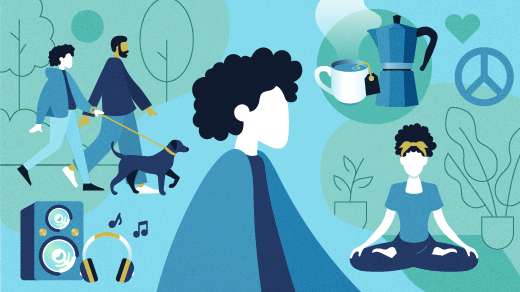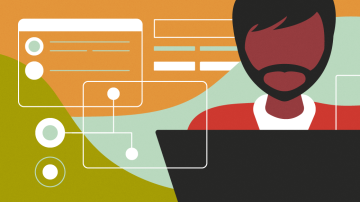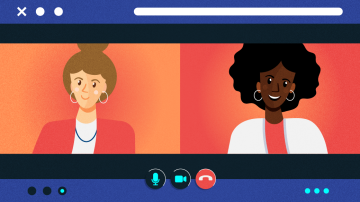Throughout much of 2020, virtual meetings have been a major part of our lives. This is new for many of us—while we may have participated in webinars or other virtual meetings on occasion, we have never relied on our webcams for doing our day-to-day work.
This has created a new phenomenon known as "Zoom fatigue," the "tiredness, anxiety, or worry resulting from overusing… virtual platforms" like Zoom, Microsoft Teams, Skype, and Facetime.
When I first heard this term during a breakout session on the fourth day of a four-hour-a-day virtual training, it became clear that I have been suffering from this new form of mental exhaustion. Curious to learn more, I decided to talk to other people who are suffering this type of fatigue in their new work-at-home life. I interviewed five people from different backgrounds and jobs to see how they're dealing with such a big change in how they operate. I spoke with:
- James Yorke, a systems and solutions engineer in South Florida: "I'm basically a system administrator, overall IT guy, and project manager all in one. It's about as exhausting and wide-reaching as it sounds."
- Peter Cashwell, author of the children's book The Amazing Q and a teacher in Richmond, Va.: "I teach English at Maggie L. Walker Governor's School (MLWGS). I taught there part-time last year, but this is my first year full-time. I started teaching in 1991 and spent most of my career at Woodberry Forest School in rural Virginia."
- Briana Passell, a customer service representative in Winchester, Va.: "I work in the customer service department for the second-largest cabinet company in America. My section deals with mom-and-pop shops and builders. I kind of do everything; I take phone calls, answer emails, problem solve, coordinate deliveries, and input orders either manually or automatically."
- Melaine Aufdermaur, a librarian in Sacramento, Calif.: "I'm a community college librarian. I also live with chronic fatigue, pain, ADHD, and mental illness. I add this because these things greatly impact my baseline energy levels."
- Adrienne Alden, a therapist in Raleigh, N.C.: "I am a licensed marriage and family therapist. I work with couples and individuals striving to have healthier relationships."
I hope this article helps you better understand how Zoom fatigue may be playing a role in your life and provides helpful tips for dealing better with it.
Jess: Meetings can be exhausting in-person or virtual, but which is more tiring, day in and day out?
Peter: I was teaching at MLWGS last March when the pandemic closed the school building. Though I'm teaching five classes now (instead of the two I taught last year), I think virtual is the main reason I'm more fatigued these days.
James: I was working in a physical office in South Florida; once the pandemic hit, our entire team went remote-only. I'm at high risk for COVID-19, so I've continued working remotely even after the vast majority of my company returned to the office. Virtual meetings can be a bit more taxing, as people are muted randomly, have poor audio quality, or often speak over each other unintentionally. In person, a lot of those logistical issues don't exist, and you can better read the room.
Briana: We had only been in the building for a year; however, I have found that in-person was far more exhausting than the virtual meetings for me.
Melaine: Virtual meetings are definitely more exhausting. I have trouble with audio processing, so it's extra tiring to not be able to see people properly.
Adrienne: I was working in an office before the pandemic; I would say virtual meetings are more exhausting. I am now tracking emotions and content as well as thinking harder about when it's my turn to talk due to internet lag, navigating internet issues, etc. I work a lot with couples, so it's very difficult to intervene when couples are intense or combative when I am not in the room with them.
Jess' takeaways: I didn't think I would see so many issues come up about technology being an issue. Since I work in technology, I tend to ignore or fix any issues related to tech. This leads me to believe that some people may face a new level of exhaustion from the technology that I wasn't expecting.
Jess: Brief conversations (hallway chats and watercooler conversations) are not happening because we aren't in the office at all or much less often with many fewer people. Are you having fewer or more meetings now?
Peter: I do at least 10 virtual meetings per week, each lasting 75 minutes. I also do occasional meetings for the faculty, the English department, or one of my extracurricular activities. In other words, my minimum virtual meeting time is 12.5 hours per week; it's usually more like 13 or 14. The rest of the week, I'm grading work online or planning. Meeting schedules at MLWGS have always been fairly structured. I don't think we've had more faculty or department meetings or parent-teacher conferences than we did before. The additional virtual meetings have been for extracurricular activities. Overall, I may be sitting in a few extra meetings this year, but not by a huge number.
James: I'm in the midst of a lot of project work with several teams, on top of my normal workload, so I'm somewhere between 15 and 25 hours a week on meetings right now. It varies wildly, depending on the type of meeting. Some are weekly updates or very targeted to a topic and stay within the 30 to 60-minute windows as scheduled. Others are testing, troubleshooting, or working meetings to accomplish a specific achievable goal and can go to two to three hours, easily. There are fewer meetings now but more phone calls. However, there has been a rising number of meetings as people get used to virtual meeting software. My workplace wasn't prepared or trained to have virtual meetings to start with, so this was a large change with a large amount of training involved.
Briana: I'd say at the moment I'm doing close to 10 meetings a week. My meetings can range from five minutes up to an hour. It's really very variable. There are so many more meetings. Meetings over things they used to just send an email for but now feel like they need to meet about because "we're no longer in the building, and we just want to see your faces."
Melaine: I attend virtual meetings between four and six times a week, depending on if I have research appointments or instruction, which leads to about four to six hours a week. I probably have the same amount of scheduled meetings, but a decrease in the "pop over to someone's office and talk for 15 minutes about a project"-type meetings.
Adrienne: I currently do 35 to 40 Zoom meetings a week; that would be 35 to 40 hours a week, as therapy sessions are an hour long. I would say that I have more meetings now that the door has been opened for virtual meetings.
Jess: How do you feel after each meeting? After a day of meetings? A week of meetings?
Peter: What's killing me about virtual meetings is how sedentary it is. In the classroom, I hardly ever sit down; I walk around the room, or I stand at the board writing or drawing on it. Thanks to gym closures, I'm not getting nearly the amount of active exercise I was getting before the pandemic, but now I'm not getting that daily load of low-grade activity that helped keep me healthy. Now I'm planted in my chair for hours every day, and when I go for a walk of any distance, my lower back starts to protest. In addition, my concentration is shot; I haven't been able to get anything written since school started, and I was relatively productive over the summer. It's better than no school at all, and it's definitely better than in-class teaching during a pandemic, but it's coming at a cost.
James: Yesterday, I was on a solid six-hour block of back-to-back meetings, eating at my desk during one of the meetings I wasn't a primary speaker in. It's taxing, so much so that I forget to often look away from my computer screens to prevent eye fatigue. Certainly not ideal.
Briana: I'm less fatigued than in person, but it was extremely tasking to train someone on our systems and processes with virtual meeting software. I spent three weeks at eight hours a day on a virtual meeting call, training someone how to do their job. I was so tired of talking by the end of the day and feeling constantly monitored.
Melaine: It's exhausting. I'd say I have about half the stamina I would if I were working in an office. Doing this amount of concentrated virtual listening and focusing is honestly hell for my ADHD brain.
Adrienne: It depends on the day. I would say I feel pretty fatigued. Though some of the fatigue is mitigated by the fact that I am not commuting. I am able to spend more time with self-care in the mornings and evenings.
Jess' takeaways: The largest issue across the comments and conversations I've had about this topic is the sedentary lifestyle. What used to be walking from desk to desk and room to room is now sitting for several hours, only moving when you have to, with eyes on the screen and no break. Being sedentary and sitting for long periods of time can lead to long-term negative health outcomes.
Jess: Many of us are also having virtual meetings with friends and family now. How has this played out in your life?
James: We've used various platforms with family and friends. It largely depends on whether it's a group or not and what person is on which platform. We used the platforms before the pandemic, and we'll continue to use them after the pandemic. We have friends in other states and family we don't get to see often.
Briana: I generally do not do virtual meetings with family. Mostly it's just phone calls. However, I would like to start doing it more. Unfortunately, some platforms have a time limit for non-paying members, and I'm not going to pay for it.
Melaine: My mom and I would video chat frequently anyway, but I've been talking to other family members now over video as well. After the pandemic, it's unlikely I'll use virtual meetings except for talking with my mom. It's been easier to keep in touch with far-away friends in some ways, but overall it's been a lot harder to keep in contact with people.
Adrienne: I will continue to use virtual meeting platforms with family. Virtual meetings with family and friends are hard. It's not the same as being in the room with loved ones. Although it is certainly better than nothing. I am glad the pandemic happened in the age of technology, so we can at least see our loved ones.
Jess' takeaways: Since the pandemic happened in the technology age, we are lucky to have the option to do longer-distance conversations "face to face" with our families, and over time we'll have a better and better experience. This has opened the door to communicating more often with people we would usually only call on holidays once a year.
Jess: What tips do you have for making this tough situation better?
Peter: The hardest thing about virtual classes is classroom management. I have no clue about what's going on out of the camera's sight, so I don't know how many of my kids are playing with their phones during class. I don't even know how tall most of them are. It's definitely not the kind of teaching I'm used to.
James: Use a headset and microphone. The background noise when using the computer's microphone and audio is obvious in meetings. If you're using a new platform for meetings, do a test run of the meeting first to make sure everything works and the meeting isn't delayed by 20 minutes while technical issues are being resolved. Ask for help, when you need help, before the meeting. Use a background if the feature is available in virtual meetings; there are some things that we don't want to see behind you.
Melaine: Most of my social life revolves around tabletop RPGs, and we've had to transition to all-virtual games. I spend at least three hours a week on a virtual meeting platform for gaming. It takes way more energy than gaming around a table.
Adrienne: I wrote a few months ago about how to make virtual sessions better. An added tip is to put your device on something still, so you do not make the person on the other end nauseous. The only technical issue I have regularly had on virtual meetings is that the sound will randomly stop working. Exiting the meeting and coming back in seems to help.
Jess' takeaways: Most of the people I interviewed use proprietary, paid virtual meeting tools like Zoom, which they say fail to meet their needs for various reasons, including time limits and required subscriptions. I suggested they try Jitsi, a web-based, free platform that allows up to 50 people to join at a time and is easy to use, even for the less technical. It's great for creating quick meetings and sharing links, and you can enable end-to-end encryption by checking a box in the Settings.
10 tips for improving life with virtual meetings
- Stand or walk for 70 minutes a day.
- Make sure to close your eyes or look away from a screen for at least five minutes every hour.
- Choose audio-only when you're feeling video or eye fatigue.
- Keep meetings short and on agenda.
- Block time on your calendar to take breaks, and make sure to stick to it. For example, schedule your lunch and eat away from your desk.
- Be flexible with scheduling and rescheduling meetings.
- Schedule one day a week with no meetings.
- Limit your socializing virtual meetings to weeknights to save your weekends for time away from these platforms.
- Take one day a week away from your computer to do crafts, read, nap, etc.
- Make sure to take care of yourself.
Thanks to Dawn Parzych and Jen Wike Huger for helping me with this list of tips. What other recommendations do you have for coping with Zoom fatigue? Please share them in the comments.










Comments are closed.